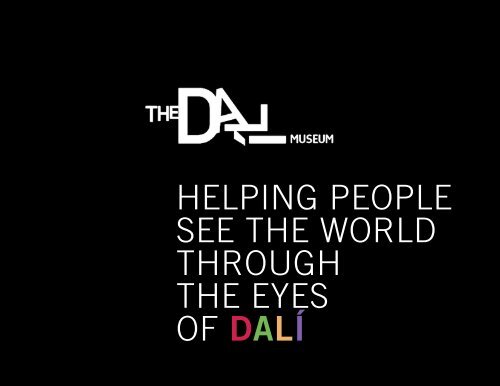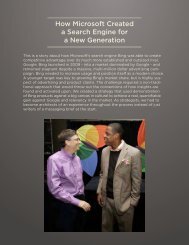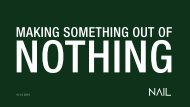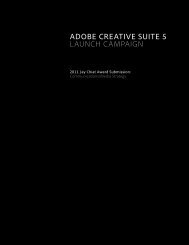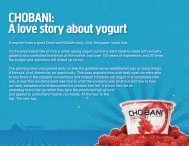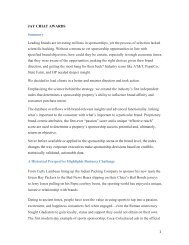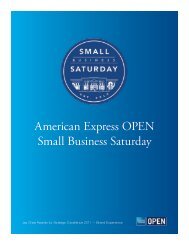Download - Jay Chiat Awards
Download - Jay Chiat Awards
Download - Jay Chiat Awards
You also want an ePaper? Increase the reach of your titles
YUMPU automatically turns print PDFs into web optimized ePapers that Google loves.
HELPING PEOPLE<br />
SEE THE WORLD<br />
THROUGH<br />
THE EYES<br />
OF DALÍ
SUMMARY<br />
Help people see the world in the way Dalí saw it. That was the simple idea behind the<br />
launch of the Dalí Museum GoodPak, developed to draw attention to the opening of the<br />
Dalí Museum’s new building in St. Petersburg, Florida. Despite having no budget, it was<br />
an idea seen by over five million people, and it created a new revenue stream of over<br />
$50,000 for a nonprofit institution.<br />
At its heart, it is a case about how the creative use of technology is changing marketing<br />
as we’ve known it, creating communication products rather than merely communicating<br />
a product. It’s a case about planning partnerships and leveraging existing platforms, not<br />
just making another “shiny object” that’s increasingly likely to be “born to die” rather than<br />
built to last. It’s a case about doing interesting things in the belief that interesting things<br />
will happen as a result. And finally, it’s about creating communication that is interesting<br />
enough that people are willing not just to participate with it, but also to pay for it.
A LOCAL MUSEUM THAT DESERVED<br />
GREATER-THAN-LOCAL APPEAL<br />
In downtown St. Petersburg lies one of the most comprehensive private collections of<br />
Salvador Dalí’s work in the world.<br />
After 29 years, the Dalí Museum was ready to move into a new building as surreal as the art<br />
on its walls. But this commitment to a new building, and the attached financial demands,<br />
meant the museum had to get more people to visit.<br />
DON’T SIMPLY COMMUNICATE A PRODUCT;<br />
CREATE A COMMUNICATIONS PRODUCT<br />
Advertising has historically worked on the assumption that you need to rent media space in<br />
order to communicate a product. We borrow attention through renting media to temporarily<br />
transmit a message.<br />
One of the most profound implications of the rise and pervasiveness of technology is that<br />
it has allowed us to think differently about the nature of communication.<br />
Now we can create our own media space that can live (theoretically) forever rather than<br />
temporarily fill the space of others. We can spend our money on making compelling<br />
content and experiences rather than spending 90% of our budget on distribution.<br />
Technology offered us a huge opportunity.
TECHNOLOGY SET US FREE<br />
The work of Salvador Dalí and the Surrealist movement was far more than simply the<br />
creation of stunning art that changed the art world. It was a philosophical and cultural<br />
movement; it aimed to revolutionize human experience by challenging what the Surrealists<br />
saw as repressive customs and structures.<br />
As with art, so with “advertising.”<br />
Using communication to merely distribute art from the museum to outside its walls didn’t<br />
live up to the museum’s mission to “educate the public and promote understanding,<br />
education and examination of the works of Dalí and other artists with a similar vision.” 1<br />
Instead, we began to think there was a huge opportunity to create an experience that would<br />
help people look at the world differently. In fact, this became our strategic imperative:<br />
Help people see the world through the eyes of Dalí.<br />
1 Dalí Museum Mission Statement
AN EXPERIENCE THAT COULD HELP US BUILD A BRIDGE<br />
BETWEEN THE MUSEUM AND CULTURE<br />
Marketing is inherently narcissistic; it’s obsessed with what we do and what we have to<br />
offer, rather than with what people are interested in. While some key museums prosper,<br />
museums in general are becoming increasingly less relevant to people’s lives, and the<br />
number of people visiting art museums is in long-term decline. In 2010 less than one in<br />
five Americans visited an art museum, down by 5% over the last eight years. 2 Less people<br />
were visiting art museums than those who played FarmVille or used a smartphone.<br />
So we thought about what people were interested in and worked back from there.<br />
And the rise of smartphones struck us as something we could potentially leverage.<br />
This placed in most people’s hands not only a powerful computing device, but also<br />
a lens they could use to view the world.<br />
More people were taking and sharing photos than ever before. Every month more than<br />
three billion photos are uploaded to Facebook. And one of the top categories in the iTunes<br />
App Store and Android Market is the photo-editing app.<br />
We realized we could help people see the world through Dalí’s eyes by creating a photoediting<br />
app. In doing so, we would build a bridge between what we did and what people<br />
were interested in and already doing. It would get people to participate with the museum<br />
and its work outside its walls. And as an added benefit, it was an idea that was inherently<br />
social and had media baked in: people could share what they had “seen” with others by<br />
uploading their photos to their social networks.<br />
2 Source: National Endowment for the Arts
HUMILITY<br />
As a typically arrogant ad agency, we presented the idea to the client, who immediately fell<br />
in love with it and didn’t blink when we said, “Don’t worry, we’ll make the app and get it up<br />
for distribution on the iTunes App Store.”<br />
We then regained control of our senses. A huge number of apps available in the iTunes<br />
App Store are never downloaded. Of those that are, 26% are downloaded, used once and<br />
then never used again. 3 Failure is pretty much the norm.<br />
If we were to be successful, we had to be humble and plan for partnership, not just<br />
product or communications. In the summer of 2010, the most popular photo-editing<br />
app was Hipstamatic. It had been downloaded 1.2 million times, and there was an active<br />
community sharing their Hipstamatic “prints” online.<br />
We approached the founders of Hipstamatic to see if they would be willing to partner<br />
with us. Serendipity struck. The founders had studied fine art, were huge lovers of Dalí<br />
and Surrealism and were keen to give back to the art community. We developed something<br />
bigger than we would have been able to pull off alone.<br />
3 http://techcrunch.com/2011/03/15/mobile-app-users-are-both-fickle-and-loyal-study/
THE DALÍ MUSEUM GOODPAK<br />
The folks at Hipstamatic loved the idea of helping people see the everyday world through<br />
the eyes of Dalí enough to agree to donate their production time for free. This, by itself,<br />
was a huge deal, as we had removed our production—not just media—costs. But this was<br />
just the beginning.<br />
Together, we created the “Dalí Museum GoodPak.” This was a photo-editing “lens” that<br />
used the idea of “startling juxtapositions” that lay at the core of the “Surrealist Manifesto”<br />
and then “printed” this image with a painterly effect.<br />
The Pak would be on sale to Hipstamatic users in their in-app store for a limited time—i.e.,<br />
the two months leading up to the launch of the new museum building on January 1, 2011.<br />
By making the product perishable, we hoped to drive not just downloads, but newsworthiness.<br />
But perhaps the most important piece of the partnership was that Hipstamatic agreed to<br />
donate all their revenue from sales to the museum, so we not only had reduced costs to<br />
zero, but also had created a potential new revenue stream for the museum. The museum<br />
would receive $0.70 every time someone downloaded their piece of communication.
LAUNCHING THE PAK<br />
One of the most powerful things about partnering with Hipstamatic was that it came with<br />
an inbuilt network of 1.2 million users, many of whom actively shared their prints online.<br />
We wanted to turn this network of users into media for the GoodPak and, in turn, the<br />
Dalí Museum. We launched the Pak with an outreach to the Hipstamatic community on<br />
their website and Facebook page. We announced a competition in which users could<br />
upload their prints using the Pak to a competition page on the Hipstamatic site. The short<br />
list of 100 prints would be decided by the votes of the community, so we encouraged<br />
people to share and campaign for their prints. The final short list would be judged by<br />
John Waters, film director and Dalí fan, with the ten best being exhibited inside the<br />
museum when it launched and the winner flown in to enjoy the opening gala. Finally,<br />
we let the community know that all the prints would be projected onto the building<br />
during the museum’s launch party. They could literally be part of the new museum.
RESULTS<br />
The Dalí Museum opened its new building to a blaze of publicity and admissions that far<br />
surpassed expectations—they are three times what they were at the old building. 4 There are<br />
many more factors at play here than the GoodPak, but we believe this was a key driver of<br />
awareness and fame, and it contributed to a successful launch.<br />
We can, however, quantify the direct impact of the idea. During the course of its two-month<br />
life-span, the Dalí Museum GoodPak …<br />
• was purchased more than 80,000 times, directly generating more than $55,000<br />
in new, additional revenue for the museum 5<br />
• generated over 19,000 mentions in blogs, social networks and forums 6<br />
• generated 2,834 photo submissions to the competition judged by John Waters 7<br />
Furthermore, the idea, due to its inherently social nature, created media beyond simply the<br />
number of people who downloaded it. If we assume that half of those who downloaded and<br />
used the Pak shared a photo on Facebook (a very conservative assumption), and that each<br />
of those had, on average, 130 friends, 8 then we can assume that over five million people<br />
were exposed to a piece of communication about the new Dalí Museum.<br />
Finally, the idea has been awarded at numerous creative award shows, from the ANDYs to<br />
D&AD. While this may all sound like a creative pat on the back, its success in winning a<br />
Next award at the AICP show means we have been able to place a small piece of the<br />
Dalí Museum in the permanent collection of the MoMA—proof that being small, nimble<br />
and smart has allowed a relatively unknown museum in St. Petersburg to invade a much<br />
larger cultural institution.<br />
4 Dalí Museum 7 "Channel your Inner Salvador" Hipstamatic Contest<br />
5 Confidential Hipstamatic sales data 8 http://www.facebook.com/press/info.php?statistics<br />
6 Social Mention


